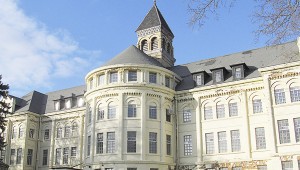
The West Tower of the historic “horseshoe” at the Fergus Falls Regional Treatment Center (Fergus Falls, MN). Much of this historic Kirkbride plan hospital is threatened with demolition.
Remaking an Eight Hundred Year Old Hospital – And We Can’t Deal with a Hundred Year Old One?!
As someone who has spent her entire career working on existing buildings, I can attest to the fact that many of my projects have been due to lack of maintenance or stewardship by owners. We all know how challenging it can be to keep up with our own homes so while I can be empathetic to a certain extent, we all need to take responsibility for our actions and sadly some of the worst owners are the largest landowners and those who should know better. I think of municipal governments and religious institutions. I bring this up because in my own world, two large historic places are currently threatened with abandonment and potential demolition – St. Ann’s Church in Buffalo and the Fergus Falls Regional Treatment Center in Minnesota.
We Need To Become a Culture of Reuse
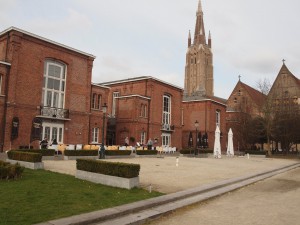
One of the entrances to the cultural center and museums that are now housed in the former St. John’s Hospital in Bruges, Belgium.
Do you remember when you started consistently recycling your aluminum cans and plastic bottles? It wouldn’t occur to most people to NOT recycle their cans anymore, so why can’t this mentality extend to buildings? Are they too big? Is it just too much to handle? Is it because we as Americans have become used to a culture of disposal? Someone else will take care of it? Is it because we have so much space here compared to other industrialized nations like those in Europe for example? If St. Ann’s is crumbling, oh well, let’s just move across town and build another church. By the time that one starts to crumble none of us will be here and it will be someone else’s responsibility. My recent trip to Europe continues to resonate as I ponder these issues and challenges.
Remaking an Eight Hundred Year Old Hospital
The oldest part of St. John’s Hospital in Bruges, Belgium dates from 1270. Subsequent buildings date from the 14th through 17th centuries. Today the complex of at least 10 buildings houses a hospital museum, a historic dispensary museum, an art and community center, a Picasso gallery and a restaurant. It was actually a hospital until 1976. It occupies a large piece of land overlooking one of the main canals and opposite the Church of Our Lady, which contains one of the only Michelangelo sculptures outside of Italy. It could be location, location, location but add to that the European ethic of reuse, and this hospital has found new uses that keeps it even more active than it’s ever been.
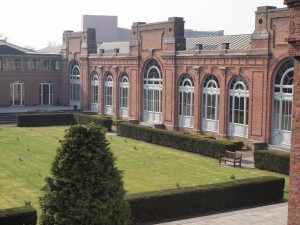
More buildings of the former St. John’s Hospital in Bruges, Belgium which are now occupied by museums and a cultural center.
What I particularly appreciated was that very little was changed. They seemed to find uses that fit well within the existing envelope and were able to use the various courtyard and garden spaces as entries to the new uses. It was a joyous place to visit and made me think that what we’re doing at the Richardson Olmsted Complex will be equally wonderful – that if you’re respecting the original use and design in such a way that the new use is also fresh enough to keep it alive, then the place could last another 800 (or in Buffalo’s case, 150) years. Durability of historic and traditional materials, plus the social and cultural sustainability of a dense historic city reminds us that “the greenest building is often the one that’s already here”, and my friends, it doesn’t get much greener than this.
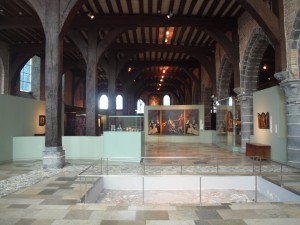
The Hospital Museum in one of the centuries old buildings of the former St. John’s Hospital in Bruges, Belgium.
A permanent Picasso exhibit extends through several buildings and two floors. The hospital museum displays archaeology of an earlier building, stories about staff and patients and a wall of medical implements. The one criticism I would make is that while each of the new uses seems to fit well in its location, it is hard to get a sense of the overall historic plan of the hospital. We had been walking through it for a while before I realized we were there. Maybe it was just me, as someone who does this for a living, but I wanted to understand how the hospital had functioned and what each new use was occupying. But if this is the worst or only criticism I have, that’s something I can accept as long as this historic place has found a successful reuse and continues to contribute to its community as a place of culture and even an economic generator.
Why Do They Always Say That Preservation Has No Economic Value?
It’s really interesting when politicians or owners claim that a building is too deteriorated to be repaired when it is often their lack of action that led to that deterioration. It’s called “demolition by neglect.” Several articles I’ve read about the Fergus Falls Regional Treatment Center quote local politicians with saying that preservation of the place has no economic value. Who are these people being voted into office? Are they living in a vacuum? Study after study shows that the value of economic development of existing buildings is often the creation of jobs, and the value of historic preservation is the creation of well-paying local jobs and the retention of place and memory.
I care about Fergus Falls because it’s one of the truly terrific Kirkbride-plan hospitals remaining in the US and as someone who has spent 30 years working on and being concerned about the Richardson Olmsted Complex in Buffalo (probably the most spectacular of all the Kirkbrides), a threat to another one is a threat to them all. Nearly 70 Kirkbrides were built in the US and less than half remain. Most are in a state of abandonment or deterioration.
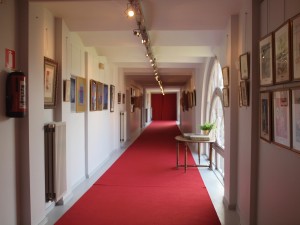
The permanent Picasso Exhibit in the former St. John’s Hospital in Bruges winds through multiple ancient buildings.
Much of the Richardson (almost 500,000 remaining square feet) had been abandoned and deteriorating since 1974, but the community never gave up and the political and financial stars finally aligned in 2006 when New York’s then governor allocated $100 M as seed money to stabilize and reuse it. Of course, the story is very complex and please review our website and this short film we made for more information.
Are Americans so quick to abandon and demolish because we have so much? Do places like Bruges reuse and save without thinking about it because it’s in their cultural DNA, or because they have less space and square footage and therefore it’s all sacred, or because access to landfills is more difficult? If landfills charged more here, charged what the real cost of demolition is to our planet, no one would be so quick to suggest that it’s easier and less expensive to demolish than reuse.
And if you’d like to “subscribe” or follow this blog, True Green Cities, please sign up through the “Subscribe” button at the bottom left of this page. You’ll receive a daily recap when new blogs are posted.
